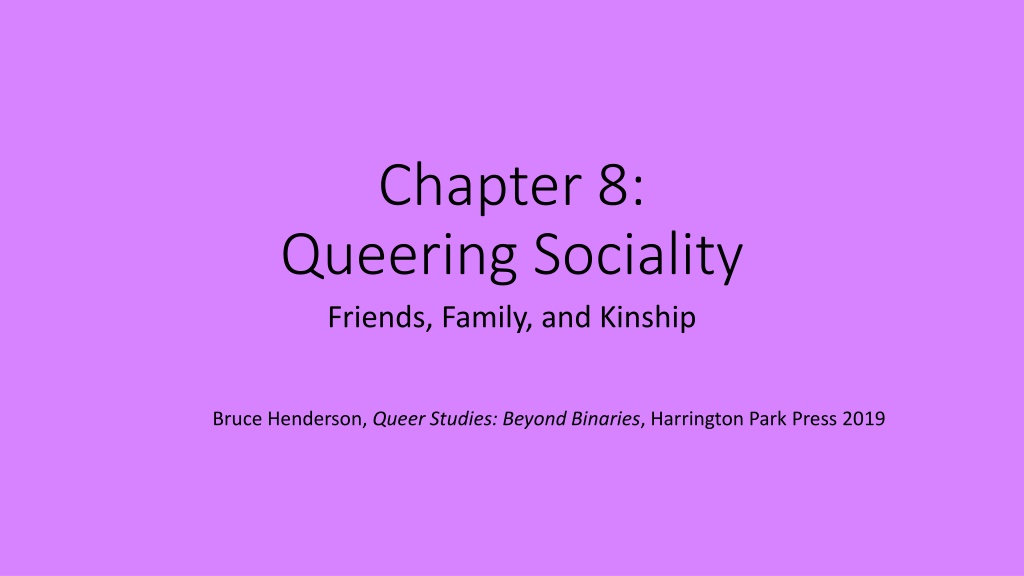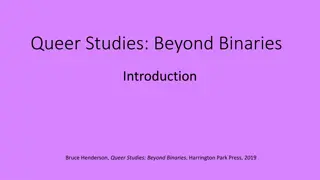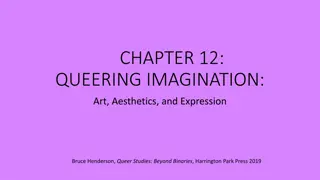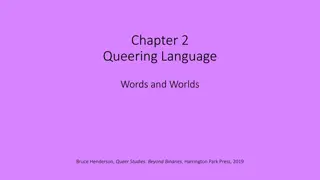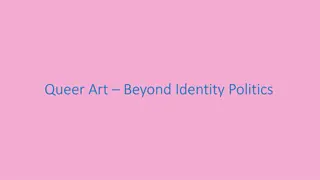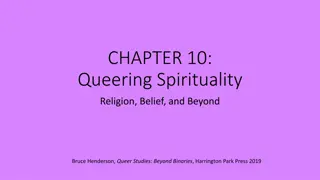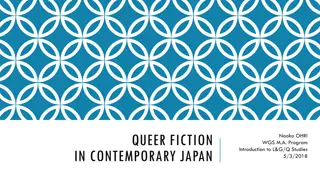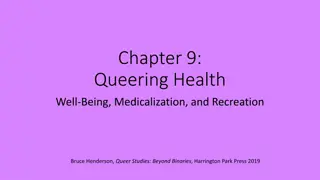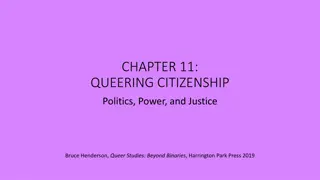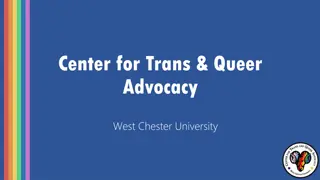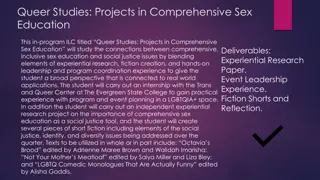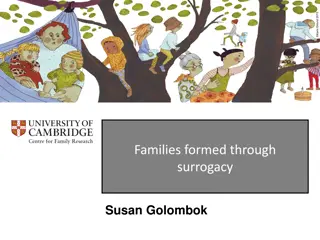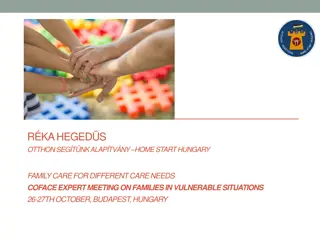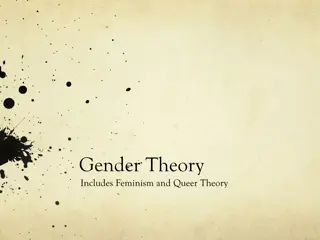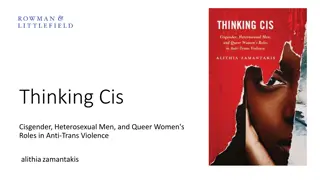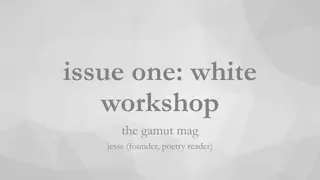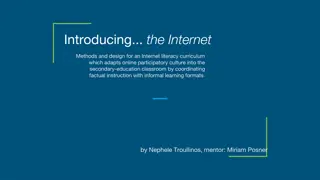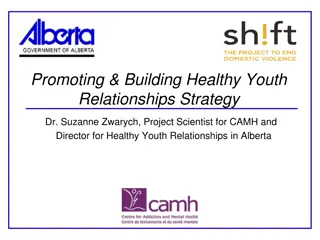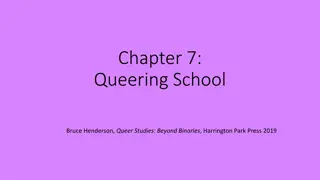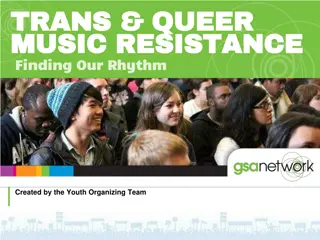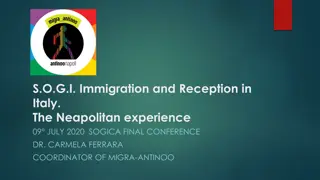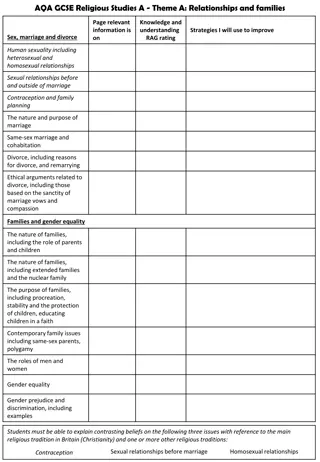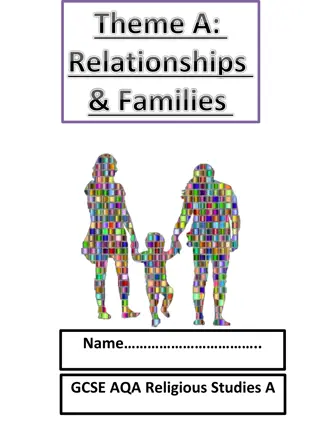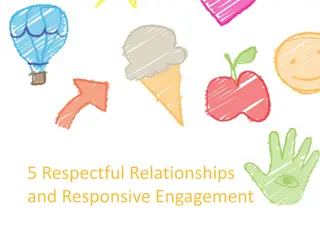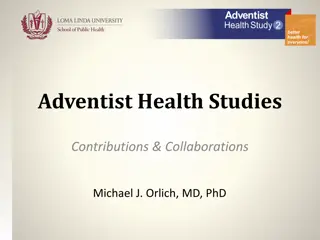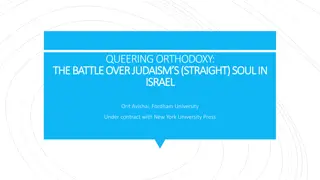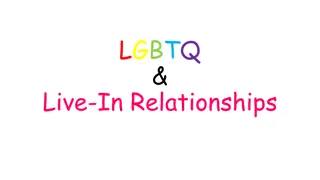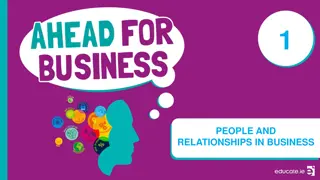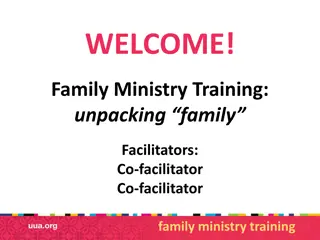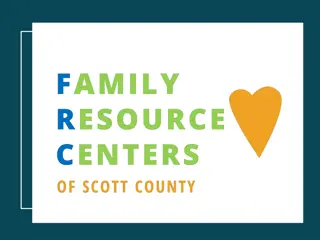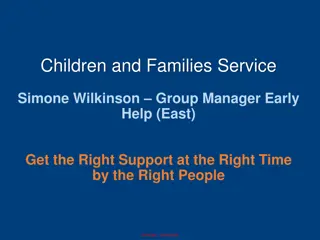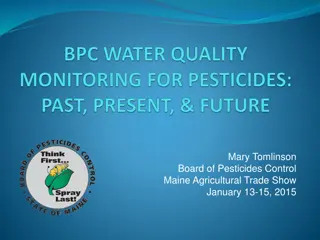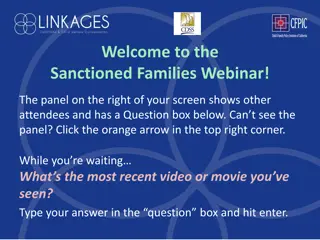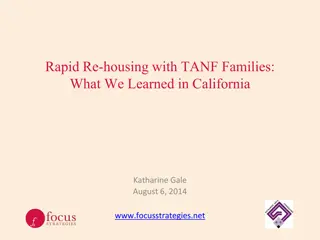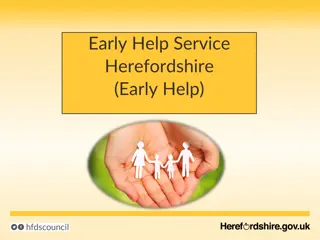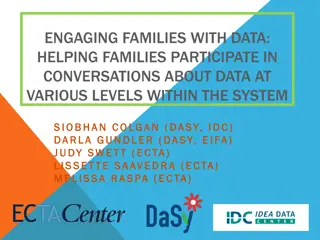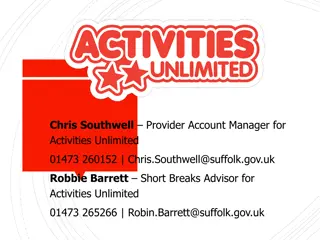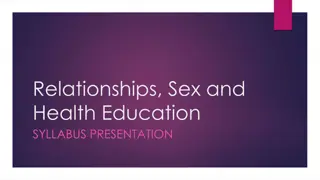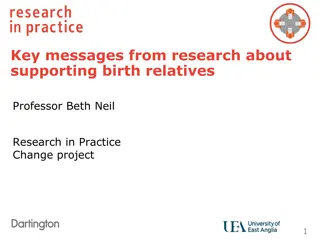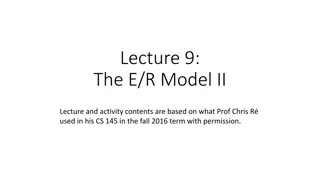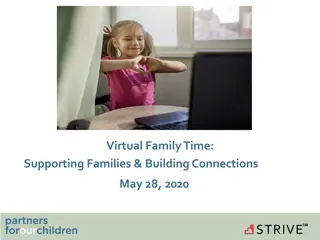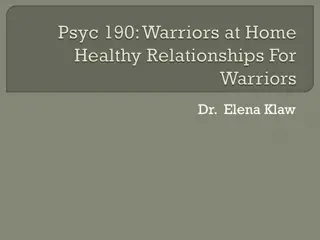Queering Sociality: Exploring Relationships and Families in Queer Studies
Explore the concept of queer sociality, evolutionary arguments for same-sex relations, queer parenting dynamics, and varieties of chosen families in the context of Queer Studies. Delve into the themes of attachment, altruism, intentional parenting, and non-biological family structures, shedding light on the diverse ways in which queer individuals form and maintain relationships.
Download Presentation

Please find below an Image/Link to download the presentation.
The content on the website is provided AS IS for your information and personal use only. It may not be sold, licensed, or shared on other websites without obtaining consent from the author. Download presentation by click this link. If you encounter any issues during the download, it is possible that the publisher has removed the file from their server.
E N D
Presentation Transcript
Chapter 8: Queering Sociality Friends, Family, and Kinship Bruce Henderson, Queer Studies: Beyond Binaries, Harrington Park Press 2019
Queer Sociality Definition: the ways in which queer people form and sustain attachments to each other Elizabeth Povinelli: sexual pleasure as a fundamental form of such bonding social bond of shared enjoyment: For trans people, social bonding may reside of in shared pleasure of identities and desire for connection Bruce Henderson, Queer Studies: Beyond Binaries, Harrington Park Press 2019
Evolutionary Arguments in Favor of Same-Sex Relations May rein in overpopulation (in urban areas, especially) Queer relatives may play altruistic roles Queer family members may reproduce values, traditions, and opportunities Bruce Henderson, Queer Studies: Beyond Binaries, Harrington Park Press 2019
Queer Parents In past, often a result of either earlier closeted life or later recognition of same-sex identity Today, more often intentional, parenting as queer person May be collaborative, with other queer people or mixture of queer and nonqueer parents Bruce Henderson, Queer Studies: Beyond Binaries, Harrington Park Press 2019
Kath Watson, Families We Choose (1997) Families of origin: blood families into which people are born Families of choice: composition and function of families not purely defined by biological links and relationships Bruce Henderson, Queer Studies: Beyond Binaries, Harrington Park Press 2019
Varieties of Families of Choice Bar culture: mixture of older and younger queer people Places of mentorship and social and erotic initiation Family roles: aunts, uncles, nephews, nieces Jenny Livingston, Paris is Burning (1990) Focus on Harlem ball scenes (vogueing) Primarily African American or Latinx Safety, security, and affection Bruce Henderson, Queer Studies: Beyond Binaries, Harrington Park Press 2019
Spotlight: Steve and Alyssa Abbott Fairyland Steve Abbott: gay man, married and became father Writer and social/political activist in San Francisco Raised daughter Alyssa after her mother died in car accident Alyssa also connected to other queer people in Steve s kinship circles (lesbians, trans people, drag queens) Alyssa returned to care for Steve as he was dying of AIDS Bruce Henderson, Queer Studies: Beyond Binaries, Harrington Park Press 2019
From Strangers to Friends to Lovers to Family: Dating, Mating, and Beyond Meeting sites: bar culture of pre-Stonewall era Kennedy and Davis: working-class lesbian bars in Buffalo, NY Brown: Kirmser s, 1940s bar in St. Paul, MN Switching bars: example of bar in upstate NY that was understood to be gay one Saturday night a month Bruce Henderson, Queer Studies: Beyond Binaries, Harrington Park Press 2019
Lisa Wade, American Hookup: The New Culture of Sex on Campus (2017) Queer students often feel excluded from campus hookup culture Perception of sexual activity greater than actual incidence Nonverbal activities, such as grinding Gender disparities: Women permitted to make out publicly (especially if they identify as heterosexual or bisexual) Men may be allowed to hookup if one time only and product of drunkenness; must be done with no public physical contact Bruce Henderson, Queer Studies: Beyond Binaries, Harrington Park Press 2019
Wade, continued Concern that hookup culture leads to depersonalization of sexual and interpersonal connections Example: Lincoln and Terrell Bruce Henderson, Queer Studies: Beyond Binaries, Harrington Park Press 2019
Friend-Kin-Lover The friend zone For queer men especially, there may be fluidity among roles of friend and lover, leading to broader sense of kinship Example: Choire Sicha, Very Recent History (2013) Bruce Henderson, Queer Studies: Beyond Binaries, Harrington Park Press 2019
Womens and Transgender Experiences Women in general less likely to hookup on first date More likely to be serial monogamists Lesbians are more likely to remain friends after the end of the romantic phase of relationship Transgender people may face more complications given the need for both gender identity and sexual desire concordance Bruce Henderson, Queer Studies: Beyond Binaries, Harrington Park Press 2019
Long-Term Relationships Couples, regardless of sexual identities, tend to move over time into companionate relationships Companionate relationships may remain both sexual and romantic, but less intensely so Reports of greater satisfaction in companionate relationships Especially for queer people (and especially for queer men), may result in mutual decisions to alter expectation of monogamy (if it was an expectation to begin with): consensual nonmonogamy Bruce Henderson, Queer Studies: Beyond Binaries, Harrington Park Press 2019
More Than Two Polyamory: being romantically and/or sexually involved with more than one other person at one time Polygamy: being in a domestic or marriage-like structure with more than one other person at one time. Polysexual: being involved sexually with more than one person, not romantically Bruce Henderson, Queer Studies: Beyond Binaries, Harrington Park Press 2019
To Marry or Not to Marry? Post-Stonewall: growth of commitment ceremonies John Boswell, gay scholar, Same-Sex Unions in Pre-Modern Europe (1994): Argued that early Roman Catholic Church supported same-sex unions, had rituals for commitment Received criticism from some other scholars about translations or context Bruce Henderson, Queer Studies: Beyond Binaries, Harrington Park Press 2019
Weddings as Performative Speech Acts Speech acts: utterances that cause things to happen Vows: I do or I take you Officiant: I now pronounce you... Varied settings: Churches and other places of religious worship Courthouses Private homes and other venues Bruce Henderson, Queer Studies: Beyond Binaries, Harrington Park Press 2019
Why Not Marry? Some queer people prefer not to make a commitment to one other person Some see it as aping or reproducing heteronormative attitudes and practices Some see it as working against all unmarried but committed couples (queer and straight) Bruce Henderson, Queer Studies: Beyond Binaries, Harrington Park Press 2019
Marriage and Transgender People Some see marriage as heightening discrimination against transgender people, because of legal issues around gender May reinforce gender binaries in harmful ways If married before transitioning, some transgender people choose to remain in the marriage; for others, pre-Obergefell laws made it impossible for trans people to marry legally Bruce Henderson, Queer Studies: Beyond Binaries, Harrington Park Press 2019
Kinship and Aging: Older LGBT Persons Successful aging: Physical well-being Mental well-being Social well-being Bruce Henderson, Queer Studies: Beyond Binaries, Harrington Park Press 2019
Jesus Ramirez-Valles: Queer Aging: The Gayby Boomers and New Frontiers for Gerontology (2016) Experience of older queer people has been understudied and undertheorized normative older person studied remains white, middle-class, male, heterosexual gayby boomers : LGB people born between WWII and ca. 1965 many queer men in this range died during AIDS epidemic Bruce Henderson, Queer Studies: Beyond Binaries, Harrington Park Press 2019
Role of Families of Choice for Older Queer People Older queer people may have experienced estrangement from families of origin Courts have sided in custody battles with nonqueer parents When parent transitions to a sex or gender other than the one a child grew up knowing: May lead to child (often as adult) questioning past family history Susan Faludi, In the Darkroom (father transitioned late in life) Alison Bechdel, Fun Home (lesbian cartoonist, closeted gay father, graphic novel and then musical) Bruce Henderson, Queer Studies: Beyond Binaries, Harrington Park Press 2019
Networks of Caring for Older Queer People Loneliness: one of the barriers obstructing successful aging Queer women: Nancy C. Nystrom , Pacific Northwest, created network that provided financial and labor support to enabled older lesbians in their homes OLOC: Older Lesbians Organizing for change Queer men: less successful in networking to provide care for each other Bruce Henderson, Queer Studies: Beyond Binaries, Harrington Park Press 2019
SAGE (Service & Advocacy for GLBT Elders): Unique Challenges for Transgender Older Adults Lack of services (meals, transportation, education and legal services) Lack of cultural competence by providers of service, causing bias and discrimination, esp. in physical and mental health Poorer health outcomes: higher rates of disability, depression, anxiety, and suicidal ideation Barriers based on violence, employment discrimination, ability to get necessary identification papers and cards Bruce Henderson, Queer Studies: Beyond Binaries, Harrington Park Press 2019
Spotlight on Retirement Communities: Problems Faced by Queer People Nursing home and assisted facilities: queer couples may have to live in different rooms; often single queer people feel forced back in the closet. May contribute to anxiety and depression Trans people may find gender identities disconfirmed Bruce Henderson, Queer Studies: Beyond Binaries, Harrington Park Press 2019
Housing Initiatives for Aging Queer People GLARP (Gay & Lesbian Association of Retired Persons): retiring not retired founded in 1996 by Mary Thorndal and Veronica St. Claire focuses on housing options Bruce Henderson, Queer Studies: Beyond Binaries, Harrington Park Press 2019
Other Initiatives in Queer Housing for Seniors The Palms of Manasota (Florida): first retirement community aimed at queer seniors went bankrupt and no longer exists recent community initiatives in Los Angeles, New Mexico, Oregon Triangle Square (Hollywood, CA): affordable apartments percentage of housing saved for seniors living with AIDS sliding scale for rent (minimum eligibility: $13, 000) still out of range for some retired/unemployed/underemployed Bruce Henderson, Queer Studies: Beyond Binaries, Harrington Park Press 2019
